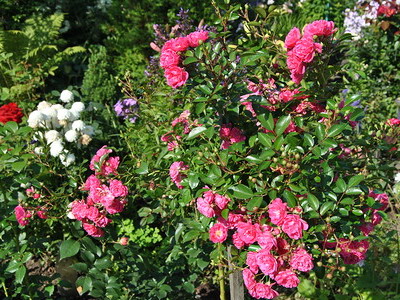Before you grow a rose on a bole, you need to collect as much information as possible about how this painstaking work is done and, of course, stock up on a fair amount of patience. Growing standard roses will take more than one year – if you start from scratch, that is, with the selection of seeds, it will take about seven years to get a beautiful tree. But this long process is worth it – a rose on a trunk grown by yourself will become your pride and a worthy decoration of the garden.
Classification of the standard form of roses
The height of the trunk can be different – from 80 cm for a large-flowered rose to 125 cm for a climbing one. Climbing roses form weeping standard forms. The crown and trunk of a standard rose are, respectively, a scion and a rootstock. A varietal scion is grafted onto a stock at least three times to create a beautiful and regular crown of a standard rose.
Until recently, there was no single classification of standard roses:
- Now the world standard has been adopted: low-stem – 60 cm, medium-stem – 90 cm and high-stem – 140 cm. Miniature roses are grafted onto boles 60 cm high, 90 cm – tea-hybrid and polyanthus, and high (140 cm) – climbing cascade forms .
One-color plantings of the standard form of roses are boring, there are long breaks in flowering. It is better to plant stems on which several varieties are grafted: the upper ones are ordinary bush, the lower ones are weeping forms.
After planting, for better survival, the boles are whitewashed, they do not overheat in the sun and are less affected by diseases.

As you can see in the photo, the roses on the trunk look very good in a small amateur garden, they create a pleasant romantic atmosphere:


Growing roses on a stem with your own hands
The following describes how to grow a standard rose yourself and how to care for a tree throughout the season:
When growing and caring for standard roses, they must be tied to pegs. It is not easy to graft and grow them, which is why they are more expensive than ordinary bush ones.
Most standard roses are pruned like shrub roses.
Weeping standard roses are climbing varieties grafted onto wild roses at a height of about 1.5 m. In the spring, they completely remove the old shoots, and shorten the young ones by a third. If this is not done, they will become too long and the bush will lose its shape.
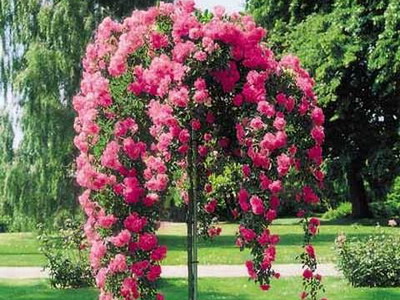
In the process of growing a standard rose, in mid-August, the stock should be budded with different varieties (4-5 buds at a height of 120-150 cm). Each branch on the stem is budded at the base. Bushes grown from these buds branch better and are not broken off by summer winds as much as those that grew from buds grafted on the stem itself.
Good weeping seedlings are obtained from climbing and ground cover roses with thin, flexible shoots descending to the ground. They are disease resistant and winter well.
When caring for a standard rose in spring, the plant is opened and tied to the established supports. Rose hips are pruned over grafted buds, and well-developed seedlings grow by autumn.
Standard roses will decorate any site. With hanging flowering shoots, they look great against a green lawn or blue sky, and also in combination with low spray or ground cover roses planted between them.
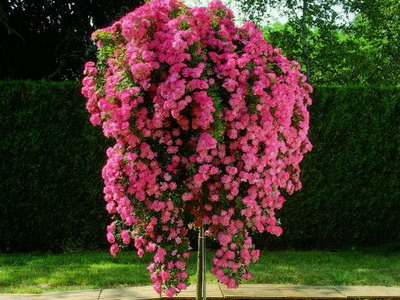
Standard roses with dark flowers are well planted between white, yellow and light pink varieties. Cream or white roses are planted with orange varieties. 2 – 4 – colored stems are best placed separately.
In total, in order to grow a standard rose, starting from rosehip seeds, it takes 7 years.
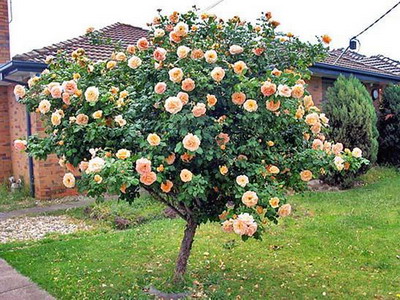
Look at the photo “Care for standard roses” presented on this page:


Planting and caring for standard roses in autumn and winter
When growing stem rose seedlings, the main thing is to get an even and strong rosehip stem. The higher it is, the better. It is not difficult to grow rose hips for a stock if you know a number of features. Rose hips for sowing must be collected brown in mid-August, seeds should be isolated from them and immediately sown in moist soil without stratification. In dry weather, crops are watered. In the spring, rose hips sprout together and grow until autumn.
Such roses are planted in a permanent place at a distance of 120 cm from each other, and weeping forms – 180 cm. When planting standard roses and caring for them, bamboo stakes are used for support, they are durable and beautiful.
Rosehip is grown for 3-4 years. All this time it is watered, loosened, sprayed from diseases and pests. In the 5th year from the root, it gives strong, even shoots of renewal, and then all side branches are removed, except for one best shoot, which at the end of July, when it reaches 1.5 – 2 m, is pinched for lignification.
In autumn, after leaf fall, rosehip seedlings are dug up, sorted, the largest ones are selected and planted according to a 150×20 cm pattern. Wide aisles are made so that there is enough land for hilling occulants for the winter.
When caring for stem roses in the fall, after the leaves on the wild rose have fallen, the stems of the oculants are tilted along the row, tying them at the soil surface to the bases of other stems, and spudding with earth from the aisles.
Caring for standard roses in winter should be especially skillful: they need to be cut off in time and protect the grafting site in the cold.

The video “How to grow standard roses” will help you better understand the whole process technology:
How to care for standard roses: fertilizers and top dressing
How to care for standard roses to provide them with adequate nutrition:
The soil around the boles must be mulched with humus, chopped straw or sawdust to retain moisture, because the bare ground dries out quickly. Water and loosen the soil under standard roses more often than under ordinary spray roses. It is necessary to water, preventing water from getting on the leaves, i.e. not by sprinkling, but by letting into the hole of the trunk circle. Moisture drops on the leaves, especially in the second half of summer, contribute to the intensive development of fungal diseases.
Fertilize standard roses annually, and more than once. In the spring, after pruning, mineral fertilizers are applied to the soil with a predominance of nitrogen along with humus. Humus leafy soil is taken in old forest belts, removing the top layer up to 10 cm thick. This is excellent soil for other cultivated plants, it is formed from rotted leaves and branches. Fertilizer mixtures are also used, which are purchased in specialized stores; the doses of their use are indicated on the packages.
The following top dressings are best timed to coincide with the development phases of roses:
- after the first flowering;
- after the second flowering (complex mineral fertilizers alternate with mullein infusion);
- after the third flowering in late summer – early autumn ( potash-phosphorus fertilizers are good).
During the summer, foliar top dressing is necessary with solutions: “Kemira Lux”, “Mortar”, potassium humate alternately. Mortar and Kemir Lux contain nitrogen, phosphorus, potassium, magnesium and trace elements: boron, copper, iron, manganese, molybdenum, zinc.
These substances not only give good growth and development of roses, but also partially protect them from diseases.
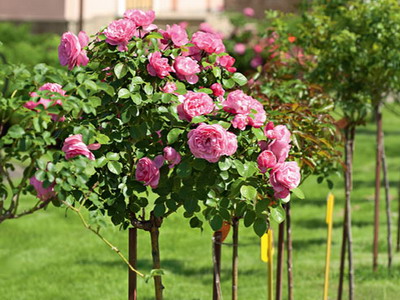
Recommended varieties for grafting into stems and photos of stem roses
The recommended varieties of roses for grafting into trunks are large-flowered, multi-flowered, climbing re-blooming shrub and miniature roses.
In almost every group of roses there are standard varieties suitable for grafting:
“Gloria Day” . The ageless Gloria Day variety looks very impressive at a height. On a trunk 90 cm high, its flowers are located at the level of the spectators’ faces. A similar variety was not bred before him and is unlikely to be bred after. On boles, its large flowers look even more graceful than on spray roses.

“Charles de Gaulle” . The flower is lilac-blue, the buds are tall, pointed, the pedicels are long, double, 30-40 petals in one flower, the flower diameter is 10 cm, it has a persistent aroma. Flowering: profuse. The leaf is light green, highly glossy. Resistance to diseases is average, frost-resistant variety. The height of the bush is 50-100 cm. The aroma is rich.
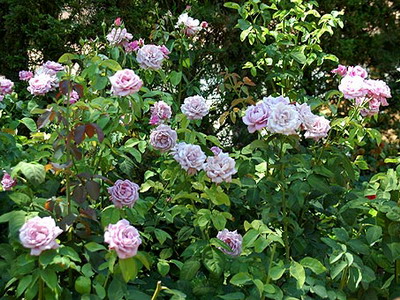
“Cardinal de Richelieu” – a rose from the group of shrubs. Flowering continues for a month.
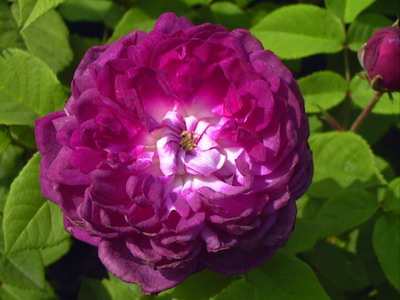
As you can see in the photo, this variety of standard rose has double flowers of medium size, dark purple:
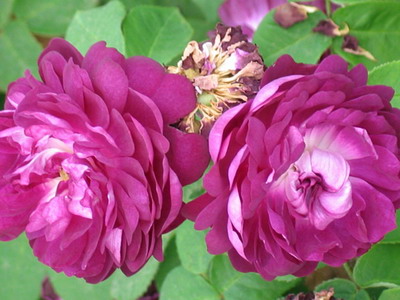

The flowers are fragrant, collected in racemes. Dark green leathery leaves numerous, shoots almost without thorns. The bush is compact. The advantages of the variety are winter hardiness and high resistance to diseases.
‘Ingrid Bergman’ is a hybrid tea rose with medium double (35 petals) dark red flowers of medium size. In culture since 1985. The flowers are fragrant, flowering is plentiful. The leaves are dark green, very shiny. The advantages of the variety are winter hardiness and high resistance to diseases.
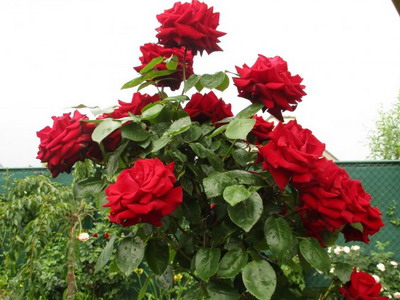
“Lilly Marlene” – the buds of this floribunda rose are almost black in color, the blooming flowers are dark red, medium in size, have 25 petals. The aroma is weak. The leaves are shiny, green with a bronze sheen. The bush is vigorous, up to 80 cm high. The advantages include the resistance of flowers to rain and sun, the disadvantages are poor resistance to diseases .

‘Lions Rose’ is a floribunda rose with large, cupped, very double flowers. The color of the petals is creamy white, with a yellow-apricot center. The flowers are collected in inflorescences of 3 – 5 pieces. Flowering is abundant and long. Has a pleasant aroma. The foliage is green, dense. Bushes are medium. The advantage of the variety is high frost resistance.

“Lübecker Rotspon” is a floribunda rose with wine-red goblet-shaped flowers. Flowers are collected in large inflorescences. Blooms very profusely until frost. The leaves are dark green, shiny. Bush up to 60 cm high, straight shoots.

“Pascals” is a hybrid tea rose with creamy white medium-double (35 petals) not very large flowers. The aroma is weak. The leaves are green, very shiny. The bush is vigorous, 110 cm high, the shoots are straight. The advantages of the variety are winter hardiness and resistance to rain.

“Scarlet Queen Elizabeth” – floribunda rose with orange-scarlet densely double flowers. The buds are in the form of hybrid tea roses, but the flowers are collected in racemose inflorescences. Differs in very long blossoming. The leaves are bronze-green, shiny. The bush is vigorous, up to 120 cm high. The shoots are straight.

“Freesia”, or “Korresia”, or “Sunsprite” , – a floribunda rose with double (25 petals) bright golden yellow flowers with a diameter of 6 – 8 cm. Flowering is very long. The aroma is weak. The leaves are green, very shiny. The bush is moderately vigorous, 70-80 cm high.

They also use the popular variety from the hybrid tea group – “Flamingo” .

“Samba ” – from the floribunda group.
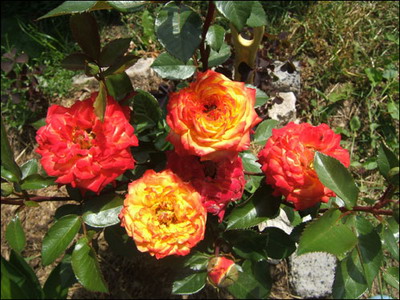
“Iceberg”.
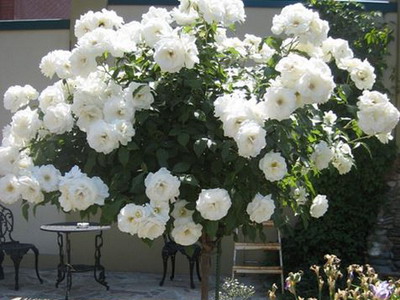
“Fairy” – from the group of polyanthus.
